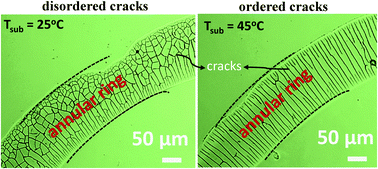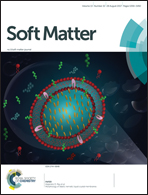Tailoring crack morphology in coffee-ring deposits via substrate heating†
Abstract
The drying of a sessile drop consisting of colloidal particles and the formation of particulate deposits with spatially periodic cracks were ubiquitous. The drying induced stress, which is generated during the evaporation of a colloidal drop, is released by the formation of cracks. We find that the morphology of cracks formed in particulate films dried at substrate temperature, Tsub = 25 °C is markedly different from that of cracks formed at Tsub > 45 °C. The cracks are disordered in the former case, but ordered and periodic in the latter. The disorderedness of cracks observed at Tsub = 25 °C is mainly due to the formation of a coffee-ring like particle deposit that exhibits a larger height gradient. The ultimate deposit pattern after complete drying is observed to be different for colloidal dispersion drops evaporated at different substrate temperatures. This is attributed to temperature-dependent solvent flow mechanisms and capillary-driven flow, which occur inside the colloidal drop during the course of drying. In addition, for the coffee-ring-like particulate deposit obtained at Tsub ≤ 45 °C, the ratio between the width of the deposit w and the radius of the ring R scales with the volume fraction of the colloids φ, w/R ∼ φ0.5, in the range of volume fractions studied in this work. The deposited patterns obtained at temperature Tsub > 45 °C are largely dominated by the capture of particles by the receding liquid–vapor interface. This is due to the faster rate of decrease of the liquid–vapor interface position with an increase in substrate temperature.



 Please wait while we load your content...
Please wait while we load your content...